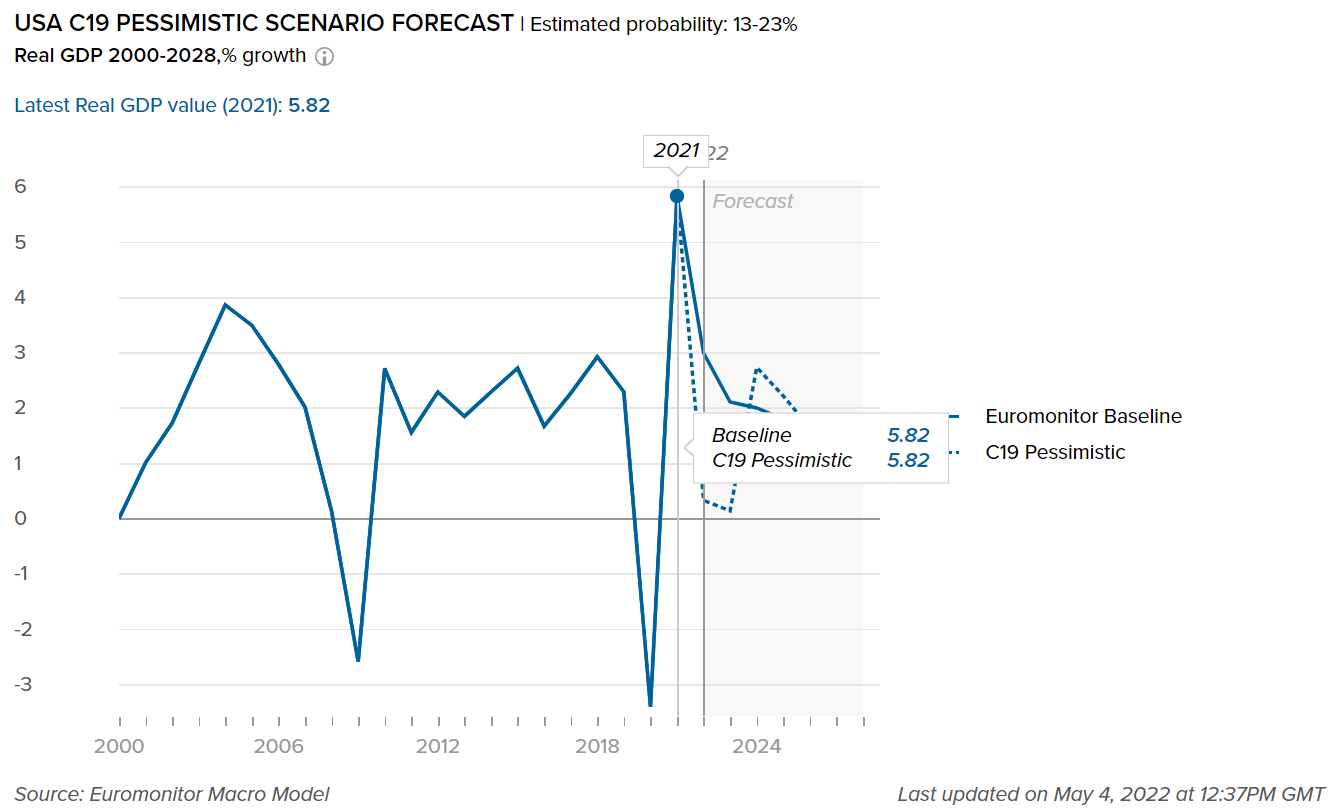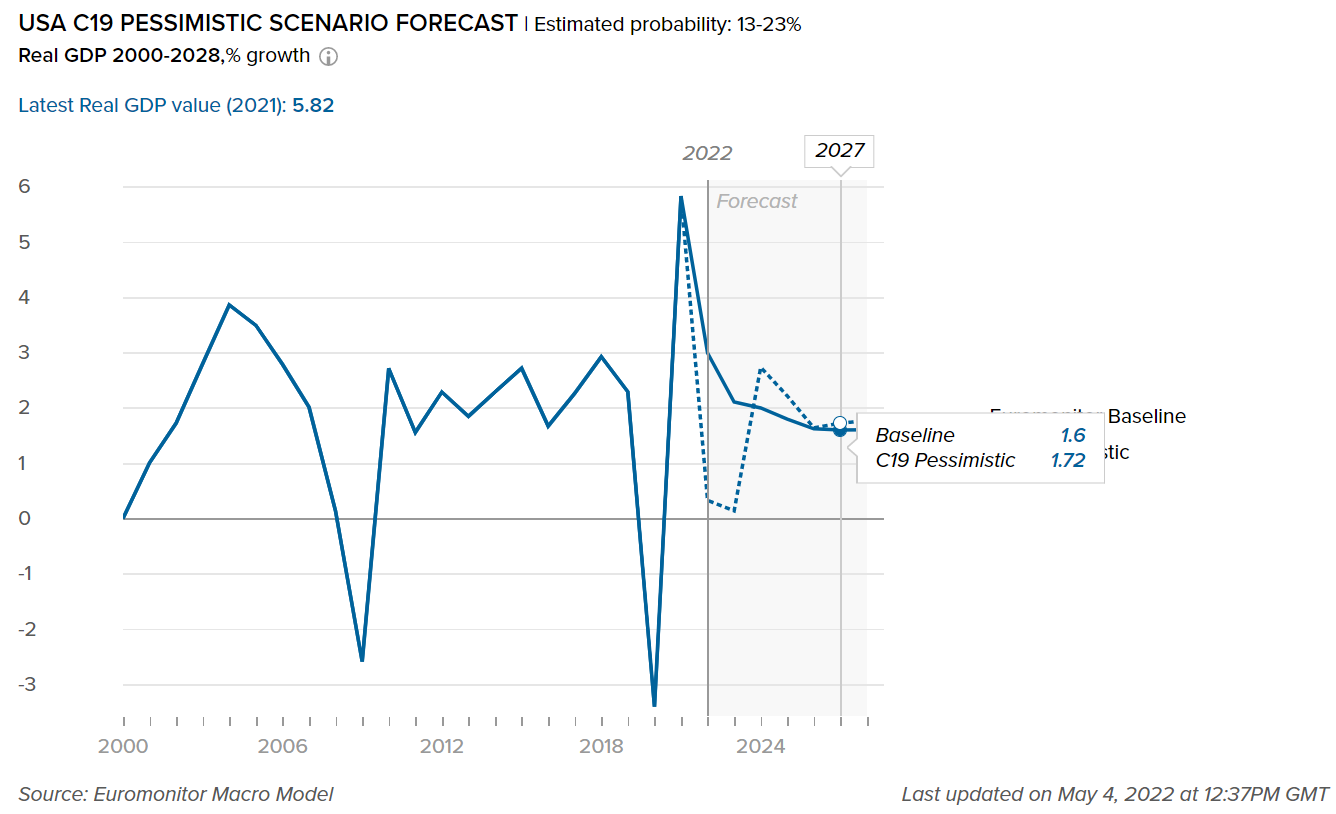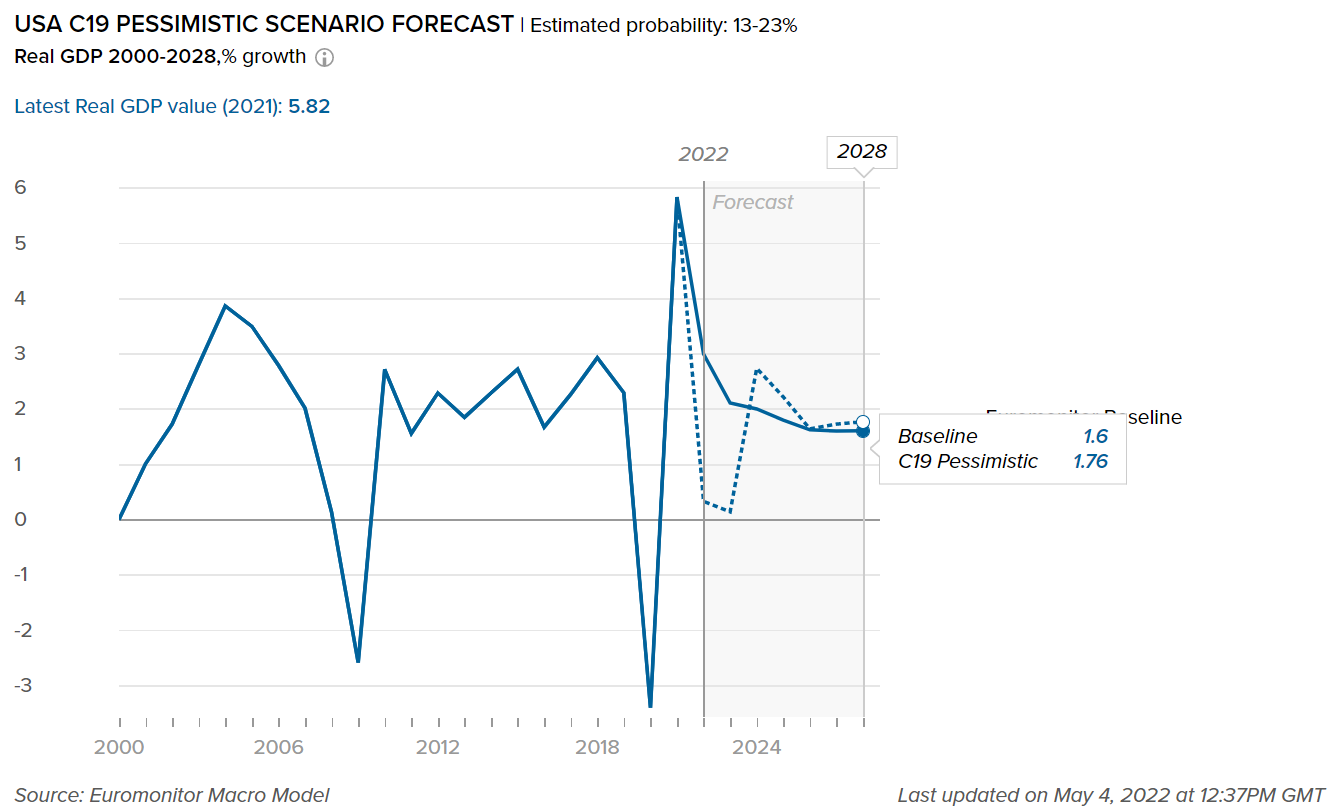Overview
- Packaging Overview
-
2020 Total Packaging Market Size (million units):
514,262
2015-20 Total Packaging Historic CAGR:
2.6%
2021-25 Total Packaging Forecast CAGR:
-1.9%
Packaging Industry
2020 Market Size (million units)
Beverages Packaging
235,652
Food Packaging
240,515
Beauty and Personal Care Packaging
15,418
Dog and Cat Food Packaging
13,520
Home Care Packaging
9,157
Packaging Type
2020 Market Size (million units)
Rigid Plastic
174,479
Flexible Packaging
136,389
Metal
121,221
Paper-based Containers
45,729
Glass
29,729
Liquid Cartons
6,069
- Key Trends
-
Due to COVID-19 restrictions and the threat of the virus, the extended shelf life of a product has become particularly important for consumers as now they are buying larger packs and multipacks, which decreases their frequency of trips outside. Also, e-commerce is expanding, with more U.S. consumers now buying groceries online as it provides the convenience of home delivery. This will lead to growth in packaging materials that can be stored and transported with ease.
- Packaging Legislation
-
There was a huge momentum building towards legislation on sustainable packaging with the Extended Producer Responsibility (EPR) bills, but the onset of the pandemic has halted its progress. But some green campaigners believe that the popularity of EPR programs for packaging will soon rise again as consumers of the U.S. are becoming more conscious about the benefits of sustainable packaging. This might help in faster adoption of the bill than earlier expected, forcing manufacturers to innovate new and sustainable products.
- Recycling and the Environment
-
In 2019, the Materials Recovery for the Future (MRFF) consortium funded a pilot project designed to see if recovered post-consumer flexible plastic packaging can be efficiently sorted and bundled for recycling. This plastic packaging was to be collected from those containers in which all types of waste were present. In 2020, MRFF revealed that the pilot project was successful. The project is reported to be the first of its kind in the country, and the project is hailed as offering a replicable model for other communities throughout the U.S.
- Packaging Design and Labelling
-
The rapid rise of e-commerce, especially during the pandemic, has pushed development in several fast-moving consumer goods packaging categories, including home care. Manufacturers are producing more reusable and refillable packs. Procter & Gamble launched smart plastic pouches, which have become highly popular with online shoppers. The plastic pouches function as refills for larger detergent bottles, and are more durable and flexible than traditional containers.
Click here for further detailed macroconomic analysis from Euromonitor
- Definitions
-
- Beauty and Personal Care Packaging: This is the aggregation of packaging for baby care, bath & shower products, deodorants, hair care, color cosmetics, men's grooming products, oral hygiene, perfumes & fragrances, skincare, depilatories, and sun care. Black market sales and travel retail are excluded.
- Dog and Cat Food Packaging: This is the aggregation of dog and cat food packaging.
- Packaged Food Packaging: This is the aggregation of packaging for baby food, Bakery, canned/preserved beans, canned/preserved fish/seafood, canned/preserved fruit, canned/preserved meat and meat products, canned/preserved tomatoes, canned/preserved vegetables, other canned/preserved food, confectionery, chilled fish/seafood, chilled lunch kit, chilled processed meats, fresh cut fruits, dairy, dessert mixes, rice, frozen bakery, frozen desserts, frozen meat substitutes, frozen processed fish/seafood, frozen processed potatoes, frozen processed poultry, frozen processed red meat, frozen processed vegetables, other frozen processed food, ice cream, meal replacement, noodles, oils and fats, pasta, ready meals, sauces, dressings and condiments, snack bars, soup, spreads and sweet and savory snacks.
- Home Care Packaging: This is the aggregation of packaging for laundry care, dishwashing products, surface care, chlorine bleach, toilet care, polishes, air fresheners, and insecticides.
- Beverages Packaging: Beverage packaging is the aggregation of alcoholic drinks packaging, hot drinks packaging, and soft drinks packaging.
Beverages
- Overview
-

- Flexible Packaging Landscape
-
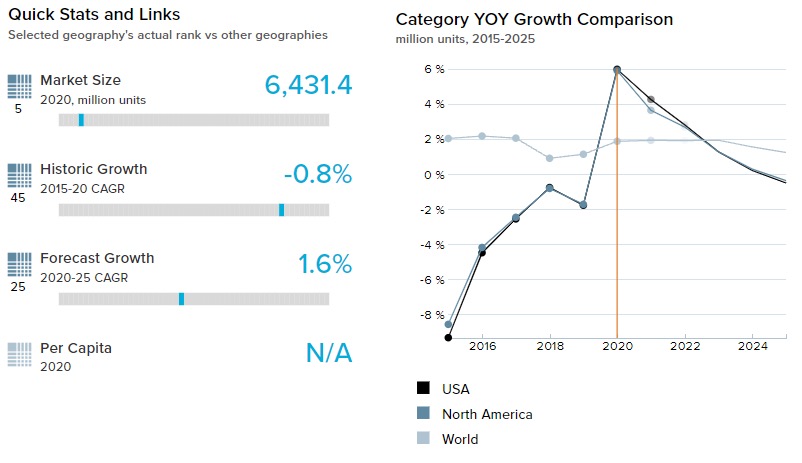
- Due to the outbreak of the COVID-19 pandemic, in-home consumption of hot drinks like coffee increased in 2020. As a result, pack types like plastic pouches that offer greater convenience for storage gained traction. This led to increased demand for flexible packaging and folding cartons, which are the most widely used pack types for hot drinks such as fresh ground coffee and coffee pods, respectively.
- The increase in demand for premium coffee in the USA continues to grow. To capitalize on this trend, German coffee maker Tchibo introduced its new packaging with enhanced capability to preserve the flavor and aroma of roasted beans and fresh ground coffee. The flexible aluminum/plastic packaging is supplemented with “Aroma Protect Technology,” which the brand claims helps to remove over 99% of the oxygen from the package, thereby maintaining the freshness of the content in the resealable bag. These products were introduced to the U.S. market in 2020.
- Trends
-
- Due to COVID-19 restrictions, people prefer fewer trips to stores. As a result, larger unit sizes and multipacks saw increases in sales. These high-volume pack types also offer consumers a better value. This shift towards larger pack sizes can also be linked to a surge in sales through e-commerce, particularly for spirits.
- Consumers became more health conscious during the COVID-19 pandemic and sought out various types of hot tea with more frequency. With this increased demand, folding cartons, which is a major pack type for the tea categories, registered a boost in its sales by growing at 7.3% in volume terms in 2020.
- Outlook
-
- Owing to criticism around the use of plastic, certain brands, such as Perrier and San Pellegrino, have started adopting aluminum-based cans over PET bottles. Due to this shift, metal beverage cans in categories such as carbonated bottled water are expected to see strong growth, driving the growth of soft drinks with a CAGR of 2.0% in total volume terms over the forecast period of 2020-25.
- A shift is expected from glass packaging to metal and paper packaging over 2020-25, as sustainability seems to be at the forefront for both the consumer and manufacturer of alcoholic drinks. Moreover, the growth in metal beverage cans is also due to increased sales of hard seltzer. as many companies are expanding into this category.
Click here for more detailed information from Euromonitor on the Beverages Packaging industry
Dog and Cat Food
- Overview
-

- Flexible Packaging Landscape
-
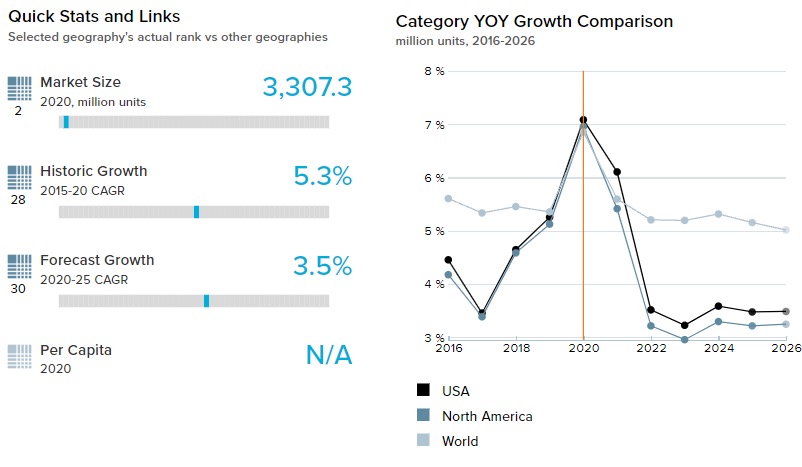
- There is an increased focus on nutrition optimization for pets in the USA and fresh dog food has benefitted from this trend. Consumers perceive wet dog food in flexible packaging, or chub packaging (air sealed tube of flexible packaging material), to be fresher than that in metal food cans. This helped the pack type to record a volume growth of 7.8% in 2020.
- Flexible packaging continues to dominate dry dog and cat food in the form of resealable bags with an easy to pour function. This helps in offering the convenience of storage and helps maintain the freshness of the product.
- Trends
-
- Reduced shopping trips due to COVID-19 is contributing to the rising popularity of larger pack sizes of dog and cat food Furthermore, the convenience of storage and price discounts provided by e-commerce websites on larger pack sizes helped increase the sales of large plastic pouches, which grew by 11.3% in 2020 in terms of volume.
- To help consumers make the right choice, there is a growing trend of clearly displaying or highlighting the product’s benefits and key ingredients on the packaging of dog and cat food items. This helps consumers to determine the correct nutritional mix for their pet’s wellbeing.
- Outlook
-
- Over 2020-25, thin walled plastic containers are expected to grow with a CAGR of 6.8% in terms of volume. This is primarily due to its suitability to store both wet and dry pet food and keep it fresh without any damage to its packaging.
- Mid and high-income pet owners are looking to buy premium pet foods in small pack sizes and manufacturers are using better graphics to attract customers. For this, plastic pouches are a perfect fit as it is easy to represent better quality pictures and graphics and plastic pouches can be easily molded into various pack sizes depending on the need of pet owners. Since this trend is expected to continue, plastic pouches are likely to show a strong volume CAGR of 5.1% over 2020-25.
Click here for more detailed information from Euromonitor on the Dog and Cat food Packaging industry
Beauty and Personal Care
- Overview
-
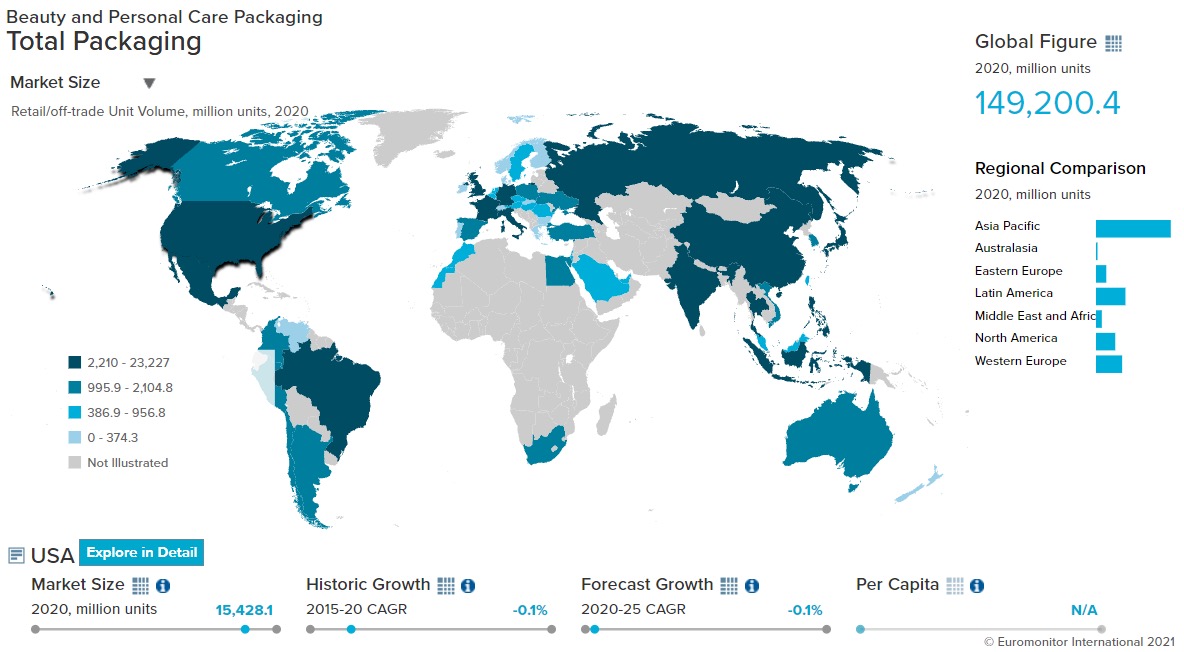
- Flexible Packaging Landscape
-

- Lockdown restrictions, disruptions to travel, work from home policies, and limited social interactions have negatively affected beauty and personal care, eroding the demand for sun care products and color cosmetics. This led to the decline of flexible packaging in beauty and personal care by 2.3% in volume terms in 2020.
- While cosmetic needs declined during COVID-19, focus on personal health and hygiene rose, boosting the growth of bath and shower products. Within this category, the main pack type, PET bottles, grew by 28.7%. Meanwhile, the newer pack type, plastic pouches, owing to its lower price point, showed stronger growth of 59.3% in 2020.
- Trends
-
- Increased focus on maintaining personal hygiene during COVID-19, also created growth in unit sales of personal healthcare items such as liquid soaps and sanitizers. This led to an increase in sales of rigid plastic packaging, especially PET bottles, which showed a growth of 28.7% in 2020.
- With the closing down of salons and people working from home due to the COVID-19 pandemic, sales of HDPE bottles and squeezable plastic tubes within commonly used at-home salon items such as nail products showed a 1.8% volume growth in 2020. This is because consumers now prefer quality home beauty treatments that prevent them from traveling outdoors and risk contracting the virus.
- Outlook
-
- Consumers have become more hygiene conscious since the pandemic began and this trend is expected to continue in 2025 as well since people will continue to use soaps and sanitizers more habitually. This will increase the sales of products within the skincare segment, especially hand moisturizers. As a result, the trend is expected to boost portable packaging formats such as flexible plastic pouches and squeezable plastic tubes which are expected to register a CAGR of 4.3% and 2.6% respectively over 2021-25.
- Since there is significant economic uncertainty and no clear timeline as to when the pandemic will end, larger pack sizes such as 946ml PET jars (CAGR of 5.5% over 2020-25) are expected to continue to grow due to the advantage they provide in terms of price and stockability.
Home Care
- Overview
-

- Flexible Packaging Landscape
-

- The shipping challenges within the e-commerce distribution channels forced manufacturers to innovate packaging materials, helping plastic pouches to grow owing to their light weight nature, flexibility, and ease of transportation. The growth of e-commerce has also resulted in the growth of liquid tablet detergents, which can be transported easily. This helped plastic pouches to grow by 11.5% in unit volume terms in the home care packaging segment.
- As consumers looked for ways to protect themselves from COVID-19 and minimize the chance of infection, many used more surface disinfectants and anti-bacterial multi-purpose cleaners. Metal aerosol cans, the most popular packaging type showed a growth of 48.3% in volume terms in 2020, followed by flexible packaging growing 29.6% in the same year.
- Trends
-
- With people choosing to stay home and restrictions on out of home dining, time spent in personal kitchens and bathrooms has increased. This has boosted the growth of kitchen and bathroom cleaners, primarily within the HDPE bottle format as it registered a volume growth of 18.6% in 2020 within surface cleaners. Whereas, PET bottles, the most popular packaging format for the dishwashing segment also saw volume growth of 14.8% during the year.
- The demand for scented candles and spray/aerosol air fresheners has increased, as many consumers sought to enhance the home environment by making use of comforting fragrances. This has resulted in the rising popularity of glass candle jars and metal aerosol cans, which registered a volume growth of 10.2% and 6.9% respectively within air care in 2020.
- Outlook
-
- As threats of the pandemic persist, and so does the consumers' focus on hygiene, and they are actively seeking out products that claim to have anti-viral properties. 3M already received U.S. Environmental Protection Agency (EPA) approval to make an anti-COVID-19 virus claim for its home care disinfectants, which will help boost the sales of PET and HDPE bottles. These formats are expected to grow at a CAGR of 2.4% and 1.6%, in volume terms, in the surface care category over 2021-25.
- The convenience and popularity of e-commerce shopping is expected to continue in the United States and so does the growth of the flexible plastic segment because of its ease of transportability. Within this packaging type, plastic pouches are the main contributor, which is expected to grow at a CAGR of 7.4% in volume terms over 2021-25.
Click here for more detailed information from Euromonitor on the Home Care Packaging industry
Packaged Food
- Overview
-

- Flexible Packaging Landscape
-
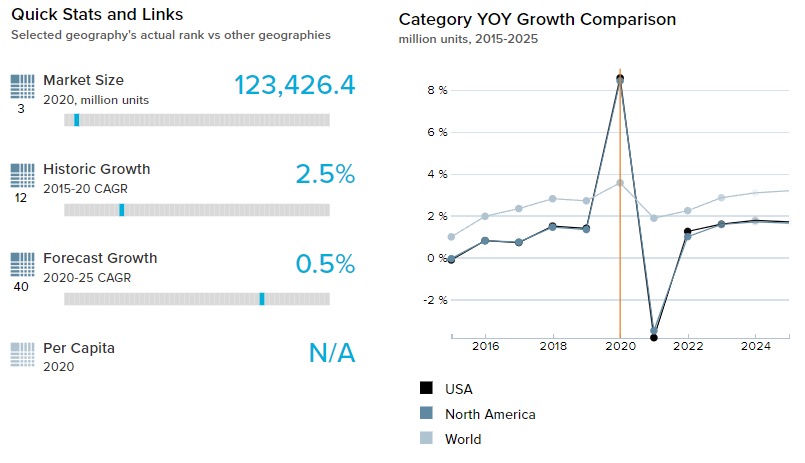
- As threats of the pandemic persist, and so does the consumers' focus on hygiene, and they are actively seeking out products that claim to have anti-viral properties. 3M already received U.S. Environmental Protection Agency (EPA) approval to make an anti-COVID-19 virus claim for its home care disinfectants, which will help boost the sales of PET and HDPE bottles. These formats are expected to grow at a CAGR of 2.4% and 1.6%, in volume terms, in the surface care category over 2021-25.
- The convenience and popularity of e-commerce shopping is expected to continue in the United States and so does the growth of the flexible plastic segment because of its ease of transportability. Within this packaging type, plastic pouches are the main contributor, which is expected to grow at a CAGR of 7.4% in volume terms over 2021-25.
- Trends
-
- Parents are increasingly concerned about the packaging waste caused by baby food products, their environmental footprint, and the future of upcoming generations due to climate change. So, manufacturers are continuously innovating for sustainable packaging solutions to make product recyclability more accessible. Gerber products partnered with TerraCycle on a national recycling program and launched single-material plastic pouches for its Organic Banana Mango Puree, which is 100% recyclable. Other players, such as Happy Family Organics, have also pledged to make all their packaging recyclable, reusable, or compostable by 2025, marking a trend towards sustainability in the baby food packaging segment.
- Lockdown measures, due to the COVID-19 pandemic created anxiety for many and an increased amount of boredom. This helped to boost demand for chocolate and sugary snacks, as a form of comfort eating. This resulted in growth of plastic pouches which grew 14.7% in the overall confectionery packaging segment.
- Outlook
-
- Processed meats and seafood consumption will decline over 2021-25 due to its growing health implications. The World Health Organization linked consumption of processed meat with an increased risk of various non-communicable diseases like cancer. As a result, meat substitutes such as organic meat and plant-based alternatives will show strong growth, especially with younger consumers. This will result in the growth of flexible packaging, as meat substitutes prefer using a plastic tray and transparent film that allows the customer to see the product before use. Flexible packaging in this category is expected to grow at a CAGR of 2.3% in volume terms during 2021-25.
- Over 2021-25, manufacturers of ready meals will increasingly be able to gain an advantage over their peers by offering packaging that is recyclable and has a low carbon footprint. This will particularly be the case in meal kits, which are mainly consumed by busy young urbanites, who are more sensitive to climate change and environmental issues.
Click here for more detailed information from Euromonitor on the Packaged Food Packaging industry
RECOVERY FROM COVID
- Overview of COVID-19 conditions in United States
-
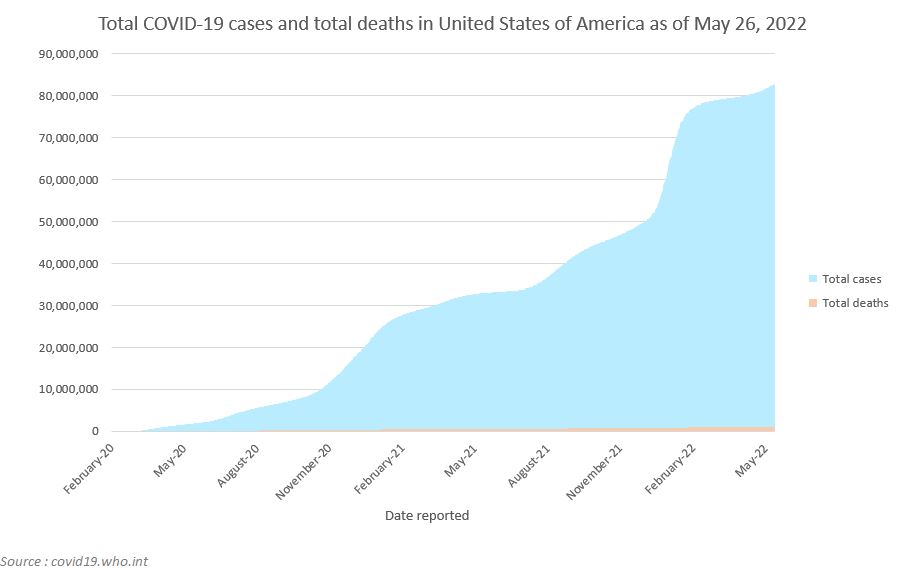
COVID-19 cases continue to rise in the USA
- According to the World Health Organization (WHO), in May 2022, the USA’s total confirmed cases stood at 82,678,161, with the total number of deaths standing at 995,391.
- According to the WHO, the USA had 249,444 COVID-19 cases per million inhabitants as of May 2022. In comparison, neighboring Canada had 101,323 cases per million inhabitants on the same date.
- In the USA, the number of COVID-19 cases continues to rise as a result of new and more infectious Omicron sub-variants, waning immunity, and fewer people masking up. Currently, at least four Omicron sub-variants are circulating across the country, with an average of 300 Americans being hospitalized each day.
- According to WHO, as of May 20, 2022, the number of total vaccinations per 100 persons in the country stood at 65.9, reaching a total of 575,410,180.
The chart below shows Euromonitor International’s Recovery Index.
The quarterly reported Recovery Index is a composite index that provides a quick overview of economic and consumer activity. It keeps track of the latest quarterly economic/consumer data and forecasts in key economies to gauge when economic activity and consumer demand are likely to return to the pre-pandemic levels of 2019.
A score of 100 and over indicates a full recovery in which economic output, the labor market, and consumer spending all return to/exceed 2019 levels.
Detailed methodology is provided in the Appendix.Quarterly Recovery Index and Related Indicators, USA

- Impact on GDP
-
This graph shows our “most probable” and “worst case” estimate scenarios of how COVID-19 will impact real GDP in the USA. Our “most probable” or Baseline scenario has an estimated probability of 45-60% over a one-year horizon. Our “worst case” or Pessimistic scenario has an estimated probability of 13-23% over a one-year horizon. For more details, please refer to the detailed explanation of the COVID-19 scenarios in the Scenario Definitions section.
Please note that the forecasts will be adjusted every three months, according to the expected number of cases, recoveries, and deaths due to COVID-19 in this country, as well as shifting socioeconomic conditions (the most recent update was May 2022).
Baseline forecast refers to the “best case” COVID-19 scenario forecast that has an estimated probability of 45-60%.
C19 Pessimistic refers to the “worst-case” COVID-19 scenario forecast that has an estimated probability of 13-23%.
Inflation pressure is likely to ease over the forecast period
- In 2021, the USA saw a strong economic resurgence, thanks to increased consumer spending, increased capital investment, and increased exports. Despite persistent pandemic-related threats, supply bottlenecks, and predicted monetary tightening in response to rising inflationary pressure, the country’s economy appears to be improving. While widespread budgetary assistance helped to reduce the pandemic's negative socioeconomic effects, it resulted in a growing budget deficit and rising state debt.
- The services sector, which accounted for 80.3% of total gross value added (GVA) in the USA in 2021, will be a major driver of future economic growth. In absolute terms, construction and real estate, finance and insurance services, and information and communications are expected to be among the primary businesses driving future economic expansion. These industries' turnover is expected to expand by 13.5%, 13.9%, and 20.6%, respectively, (in constant 2020 prices) between 2021 and 2026.
- Inflation in the USA increased to 4.7% in 2021, up from 1.2% the previous year, due to rising energy and commodity costs, increasing cost pressure due to supply restrictions, and robust consumer demand. Housing, alcoholic beverages, and tobacco products, as well as education, saw the highest price rises among key consumer goods and services in 2021. Inflationary pressures are predicted to ease in the medium term, with supply chain bottlenecks gradually easing, pent-up demand relaxing, energy costs forecast to fall, and monetary policy tightening. As a result, inflation in the USA is expected to progressively decline over the next five years, hitting 2.0% in 2026.
- Impact to Sector Growth
-
Please note that the forecasts are adjusted every three months according to the expected number of cases, recoveries, and deaths due to COVID-19 in the country, as well as shifting socioeconomic conditions.
The graph below shows the adjusted forecasts of the percentage growth for the categories mentioned, highlighting the impact of COVID-19 between our pre-COVID-19 estimates and the “most probable” (Baseline) forecast, which has an estimated probability of 45-60%.
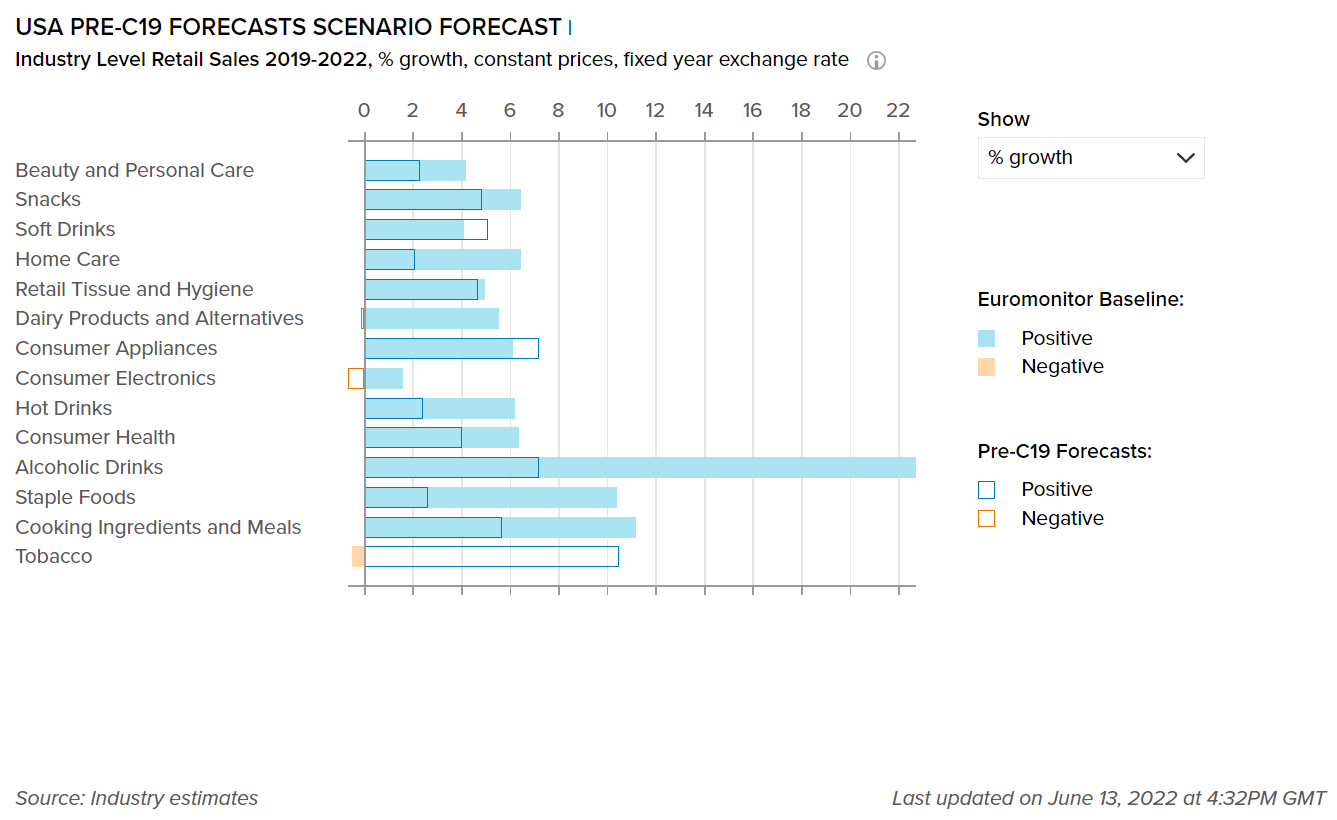
Baseline forecast refers to the “best case” COVID-19 scenario forecast that has an estimated probability of 45-60%.
E-commerce helps sustain beverages market demand
- Alcoholic beverages doubled its growth potential, showing the highest growth in the USA with 14.6% value growth over 2019-2022, according to Euromonitor’s Baseline scenario forecast, as opposed to a previously anticipated 7.2%, according to the pre-C19 scenario forecast. The growth is driven mainly by a surge in disposable income and a rise in consumer demand for premium/super-premium products, as well as craft beverages. Furthermore, the expansion of alcoholic drinks through the e-commerce channel in the USA boosted demand further throughout 2020-2021.
- With producers' expanding omnichannel presence and capabilities as a result of transient pandemic impacts, the significant growth of soft drinks sold through online channels in 2020 persisted in 2021 and 2022. Convenience-driven delivery apps, along with direct-to-consumer bottle delivery (exemplified by Coca-Cola Direct, an online storefront offering same-day delivery of Coca-Cola products in Charlotte, NC), remain focus areas for U.S. beverages, although the overall volume remains low compared to other consumer packaged goods categories.
Please note that the forecasts are adjusted every three months according to the expected number of cases, recoveries, and deaths due to COVID-19 in the country, as well as shifting socioeconomic conditions.
This graph shows our “most probable” and “worst case” estimate scenarios of how COVID-19 will impact the percentage growth for the sectors covered in the USA. Our “most probable,” or Baseline scenario, has an estimated probability of 45-60% over a one-year horizon. Our “worst case,” or Pessimistic scenario, has an estimated probability of 13-23% over a one-year horizon.

Baseline forecast refers to the “best case” COVID-19 scenario forecast, which has an estimated probability of 45-60%.
C19 Pessimistic refers to the “worst-case” COVID-19 scenario forecast, which has an estimated probability of 13-23%.
Clean beauty and self-pampering shape the future of the beauty and personal care industry
- In 2021, self-pampering regimens remained popular, assisting the rise of the beauty and personal care industry in the USA over 2019-2022. However, given legislative developments from California's Toxic-Free Cosmetics Act, which represents the USA's first state-level prohibition on beauty and personal care components, clean beauty is likely to become a cornerstone in beauty post-pandemic and certainly over the forecast period. Although the regulation only applies to one state, players are likely to adjust formulations to avoid having two versions of the same product on the market. Amazon-owned Whole Foods' beauty exchange program in 2020, in which customers may trade in old cosmetic items, demonstrates how retailers are supporting the shift to clean options.
- Impact on Flexible Packaging
-
The following tables display adjusted market size for 2021, market size forecasts for 2022, and the percentage difference between the February 2022 and June 2022 estimates for the year 2022.
Please note that for the current quarterly update, the following table covers beauty and personal care packaging and home care packaging industries only.
Packaging Industry
2021 market size as per Jun 2022 data (mn units)
2022 market size as per Jun 2022 data (mn units)
% Difference between Jun 22 and Feb 22 data for 2022
Beauty and Personal Care Packaging
17,232
16,846
10.8%
Home Care Packaging
8,657
8,483
-11.1%
Packaging Type
2021 market size as per Jun 2022 data (mn units)
2022 market size as per Jun 2022 data (mn units)
% Difference between Jun 22 and Feb 22 data for 2022
Rigid Plastic
172,825
175,773
-0.05%
Flexible Packaging
131,655
133,900
0.48%
Metal
119,947
121,622
0.02%
Paper-based Containers
42,486
43,432
-0.12%
Glass
29,110
29,336
0.23%
Liquid Cartons
5,880
5,965
0.00%
Sustainability moves back into the spotlight in the post-pandemic period
- Sustainability recovered strength in 2021 after taking a backseat in 2020 due to the pandemic, as consumers in the USA are highly aware of their impact on the environment. According to the Voice of the Consumer: Lifestyles Survey 2021 by Euromonitor International, 55% of U.S. respondents are concerned about climate change. As a result, ECOS, Seventh Generation, Dropps, Everspring, and other home care brands continue to offer green, sustainable options, and even major brands, such as Tide with Tide Purclean, incorporated plant-based alternatives. Dropps introduced a recyclable, biodegradable, and repulpable box for distributing its home care products across the USA, and Seventh Generation packages its toilet care products in highly recyclable steel boxes.
- Furthermore, sustainability remains an important challenge across the soft drinks industry in the USA. Manufacturers continue to set more ambitious global targets for packaging reuse and recycling, although the USA currently lags behind comparable markets in Europe in terms of both rPET product mix and regional rates of curbside recycling. Nevertheless, Coca-Cola announced a variety of new rPET initiatives in 2021 for the USA, including the start of a transition to 100% recycled materials in the 20 oz. bottle, and a new 100% rPET 13.2oz bottle launch over the summer. In September 2021, PepsiCo pledged to transition to 100% rPET bottles in the USA by 2030.
- Consumers, particularly Millennials and Gen Z, are projected to grow more sensitive to the environmental impact of the items they consume as global regulations and consumer demand drive the push toward sustainable packaging. Companies' sustainability activities, such as investing in refillable, recyclable, environmentally-friendly, and reusable packaging, are projected to gain popularity with consumers. As a result, brand owners are offering new solutions to achieve their sustainability objectives. In beauty and personal care, Berry Global Group partnered with Raw Elements USA, to launch a sugarcane-based tube for its natural and reef-friendly sunscreen, moisturizer, and hand sanitizer product lines in 2021. The tubes are made from sugarcane waste that is converted into HDPE and LDPE to create a material with the same chemical make-up as fossil fuel-based polyethylene. It offers a range of environmental benefits, including reductions in greenhouse gas emissions, water use, and fossil fuel consumption.
- Definitions
-
- Beauty and Personal Care Packaging: This is the aggregation of packaging for baby care, bath & shower products, deodorants, hair care, color cosmetics, men's grooming products, oral hygiene, perfumes & fragrances, skin care, depilatories and sun care. Black market sales and travel retail are excluded.
- Dog and Cat Food Packaging: This is the aggregation of dog and cat food packaging.
- Packaged Food Packaging: This is the aggregation of packaging for baby food, Bakery, canned/preserved beans, canned/preserved fish/seafood, canned/preserved fruit, canned/preserved meat and meat products, canned/preserved tomatoes, canned/preserved vegetables, other canned/preserved food, confectionery, chilled fish/seafood, chilled lunch kit, chilled processed meats, fresh cut fruits, dairy, dessert mixes, rice, frozen bakery, frozen desserts, frozen meat substitutes, frozen processed fish/seafood, frozen processed potatoes, frozen processed poultry, frozen processed red meat, frozen processed vegetables, other frozen processed food, ice cream, meal replacement, noodles, oils and fats, pasta, ready meals, sauces, dressings and condiments, snack bars, soup, spreads and sweet and savory snacks.
- Home care Packaging: This is the aggregation of packaging for laundry care, dishwashing products, surface care, chlorine bleach, toilet care, polishes, air fresheners and insecticides.
- Beverages Packaging: Beverage packaging is the aggregation of alcoholic drinks packaging, hot drinks packaging and soft drinks packaging.
- Scenario Definitions
-
Scenario Assumptions
Baseline
C19 Pessimistic
Estimated probability
45-60% over a one-year horizon
13-23% over a one-year horizon
Global GDP growth
2.0% to 4.0% in 2022
1.8% to 4.2% in 2023
-1.0% to 1.0% in 2022
-0.5% to 2.0% in 2023
COVID-19 situation
A combination of high vaccination rates with milder virus variants and widespread availability of antiviral drugs make COVID-19 an endemic disease in advanced economies.
The spread of a more infectious and highly vaccine resistant COVID-19 mutation requires intense lockdowns/social distancing measures in 2022-2023, delaying the economic recovery from the pandemic
Vaccinations
Existing vaccines remain highly effective against severe disease from new coronavirus variants, with moderate vaccine modifications.
Vaccination campaigns progress in developing economies is slower than expected.
Impact on economy
Services activity would pick up in 2022 on the back of loosening COVID-19 restrictions and released pent-up demand.
Longer lasting and much stricter distancing measures cause large drops in consumption, business revenues, employment and wages relative to the baseline forecast in 2022-2023.
- Recovery Index
-
Recovery Index Methodology
Euromonitor International’s Recovery Index is a composite index that provides a quick overview of economic and consumer activity and helps businesses predict recovery in consumer demand in 48 major economies. The index takes into consideration total GDP and factors that determine consumer spending - employment, consumer spending, retail sales, and consumer confidence. Index scores measure the change relative to the average per quarter for 2019.
Category
Weighting
Focus
Economic Activity
20%
Tracks and forecasts the level of real GDP, as this is a broad measure of everything that workers and capital produce in a country.
Employment
20%
Looks at the employed population and average actual weekly working hours in each quarter, as these indicators help track households’ primary source of income besides government financial support.
Consumer Spending
25%
Looks at private final consumption expenditure in each quarter, as this is the best official measure of consumer spending in real terms.
Retail Sales
25%
Focuses on seasonally adjusted real retail sales data as a timely indicator of economic performance and strength of consumer spending.
Consumer Confidence
10%
Looks at the standardized consumer confidence index to see how consumers across countries feel about their situation and when they will start feeling better about the future.


